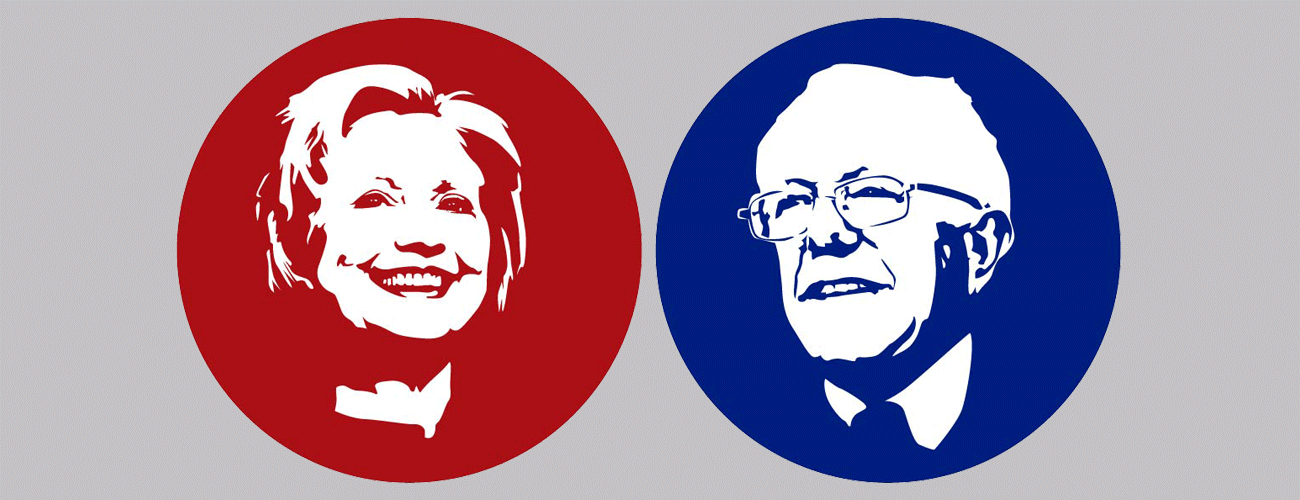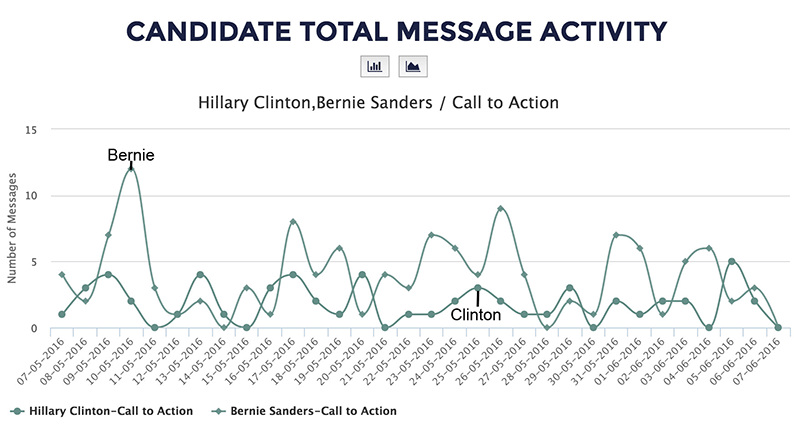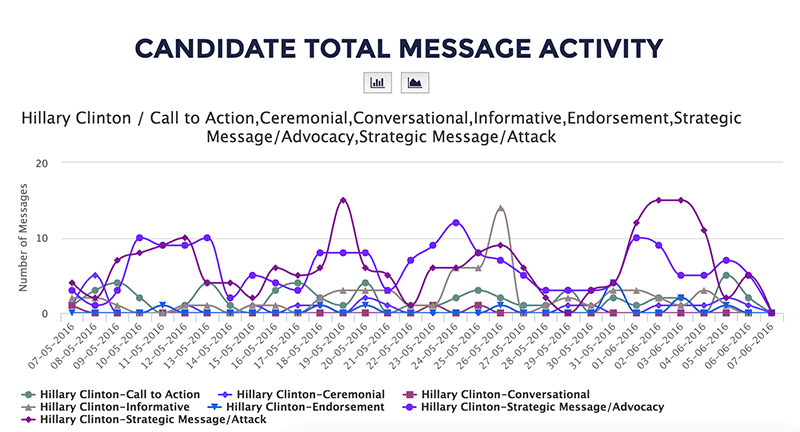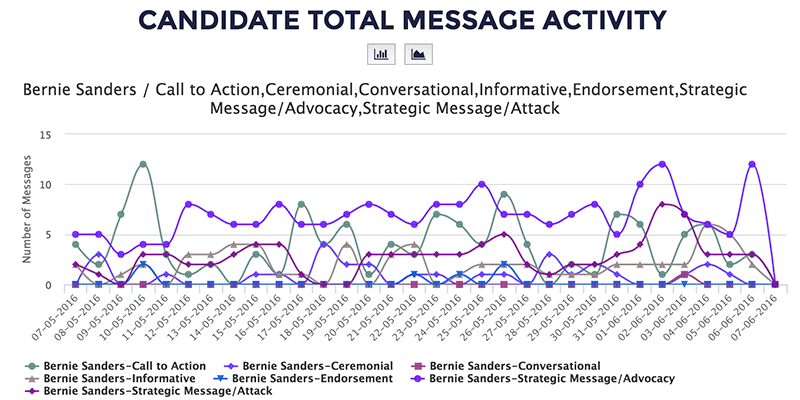Bernie Sanders rode a wave of populist support that nearly upended former shoo-in Hillary Clinton for the Democratic nomination for president. Are there lessons to learn from his campaign’s social-media strategy that explain why the Bernie movement gained so much traction but ultimately came up short?
A review of hundreds of the candidates’ messages on Twitter and Facebook—using data* from Illuminating 2016, a project supported by the Tow Center for Digital Journalism and Syracuse University’s Center for Computational and Data Sciences—suggests the candidates took very different approaches to the digital medium in the month before Clinton clinched the nomination.
Sanders’s feed had fewer negative messages, relying more on calls to action than Clinton’s feed. And despite his success with small donations, Sanders was more focused on getting out the vote than urging supporters to donate money on social media. Clinton’s strategic use of calls to action was focused on digital engagement—and attempts to create an open and collaborative campaign environment by inviting supporters to engage with policy discussions online.
The numbers
On average, Sanders posted calls to action on social media roughly four times a day, while Clinton posted twice. His efforts were more focused on Twitter, while Clinton used both Facebook and Twitter more evenly.
Total calls to action for Sanders and Clinton, respectively, from May 7 to June 7, 2016. Source: Illuminating 2016.
Sanders also relied on calls to action almost twice as much as Clinton. These are messages that engage supporters in activities that align with campaign goals. They range from traditional forms of engagement—such as donating money, buying campaign merchandise, attending local events and watching the candidate on TV—to online engagement, mostly focused at getting supporters to spread the word about the candidate among social networks, sign up for campaign updates and mailing lists, and demonstrate support in digital ways (sending pictures, creating videos, etc).
Clinton posted nearly two negative messages for each of Sanders’s negative posts.
That Sanders’s campaign used social media to mobilize and engage voters in strategic ways using calls to action helps explain why his campaign was so successful in building a substantial network of grassroots supporters. The Vermont Senator was running as an outsider with few connections to or alliances with the Democratic Party’s typical large contributors. These large donors and their Super-PACS have grown in prominence and power in the last five years. Sanders, who eschewed large donors and Super-PAC money, had to drive campaign contributions a different way if he was to have any hope of running a viable campaign.
An overview of Clinton’s messages, on the other hand, demonstrates that calls to action are not as central to her social media strategy. Most of her messages during the observed period fall into what Illuminating 2016 calls “advocacy” (35 percent)—messages aimed at constructing a positive image—and “attack” (36 percent) messages, while calls to action account for only 13.1 percent of her social media presence.
Total message activity for Hillary Clinton’s Twitter and Facebook accounts, broken down by message type. Source: Illuminating 2016.
A visualization of Sanders’s social media posts presents a very different picture: while the most used message type is advocacy (41 percent), calls to action are used second most often, accounting for 24 percent of all messages within the period. Attack follows with 17 percent—meaning that Clinton posted nearly two negative messages for each of Sanders’s negative posts.
Total message activity for Bernie Sanders’s Twitter and Facebook accounts, broken down by message type. Source: Illuminating 2016.
These percentages suggest not only that Sanders values calls to action twice as much as Clinton, but also that attacks are more central to the former Secretary of State’s campaign strategies on social media than creating opportunities to engage supporters. In other words, Sanders’s campaign appears to be more focused on motivating citizens to join his movement and spread the word about his campaign using social media than Clinton, who instead appears to be focused on constructing a positive image for herself with advocacy messages and downplaying her competitors with attacks.
Strategic differences
Drilling down further, we can see that Clinton used a mix of types of calls to action, ranging from calls to share pictures and stories, watch campaign activities online, share campaign content, and participate in Q&A’s. Digital engagement accounts for 55 percent of Clinton’s calls to action, which Clinton used in creative ways, such as asking followers to participate in a quiz about her qualifications to be a candidate and share personal stories related to policy issues.
Traditional engagement—such as asking supporters to attend to campaign events— was the second most used type of call to action, accounting for 20 percent of all messages in this category. Getting out the vote and sharing the vote on social media is a distant third, with 13 percent, and calls to support her campaign by donating money (4 percent) or buying campaign merchandise (5 percent) accounted together for 9 percent of her calls to action.
Here’s a couple examples:
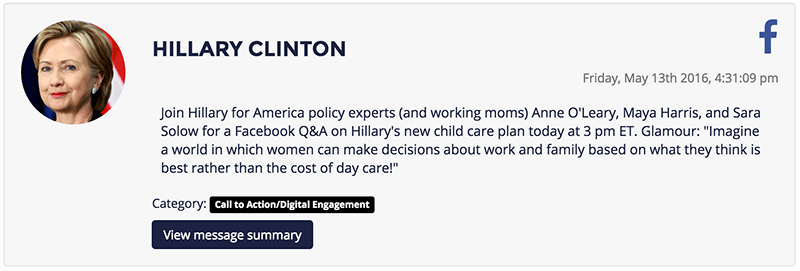

While Clinton’s campaign demonstrated a balanced mix of strategies and focused on presenting policy proposals around specific issues, Sanders’s team was more focused on getting people to join the campaign in traditional ways—by voting, attending campaign events and supporting Sanders in their own communities. His campaign also presented some innovation in terms of opportunities for engagement with a dedicated app. (Clinton’s campaign released their app only last week.)
In fact, 30 percent of Sanders’s messages on both Facebook and Twitter were related to voting, including pledges for supporters to register to vote in state primaries, go to the polls and take family and friends along, and engage with the campaign to get more people to the polls. Thirty-two percent of Sanders’s messages were for digital engagement. Those include invitations to watch campaign events and rallies online, and messages with generic and policy-related pledges to join the campaign—or “the movement.”
The candidate also used social media to ask supporters to download the campaign’s app—which contains a number of ways for people to join the campaign—as well as visit his own website, read and watch policy-related materials and go door-to-door to talk to neighbors and spread the word about Sanders.
Some examples:


Even though Sanders’s campaign was backed by a strong fundraising strategy based on small donors, asking people for donations was not among his priorities on social media.
By May 31, Sanders’s campaign committee raised $222,191,766, with small individual contributions accounting for roughly 60 percent. But his campaign actually made few pledges for donations on Twitter and Facebook during the last month of the primaries: only 3 percent of messages asked supporters to chip in, while 1 percent promoted campaign merchandise. The lack of pledges for donations on social media might suggest that his campaign was using other tools to reach supporters such as email.
On Clinton’s side, small contributions accounted for only 20 percent of the $229,202,008 raised by May 31. Fundraising was not thed focus for her either; she only asked for donations in 4 percent of her calls to action during the observed period. A closer look at campaign strategies in other digital venues, such as website and email, as well as through text messaging, might reveal more details on candidates’ fundraising than social media.
It is also interesting to note that several messages from the Sanders campaign were posted on both Twitter and Facebook, suggesting the campaign was not as concerned with exploring the possibilities of Twitter and Facebook as Clinton’s—who, at least during the observed period, did not repeat the same message on both platforms.
Clinton’s and Sanders’s campaigns are larger than just their social media presence, so we have to be careful claiming that one campaign was more participative. But this analysis does suggest that Clinton’s campaign was more open to citizens’ inputs than Sanders’s. This is counterintuitive, since Clinton represents the establishment.
The fact that Sanders’s team was more focused on getting supporters to help the campaign in various ways makes sense for a candidate who was an insurgent and needed to beat the odds—and the Democrat establishment—to become a viable nominee. Clinton, with a larger campaign structure and with the support of big donors of the Democratic Party, was more focused in making the case for her candidacy and criticizing her opponents, leaving calls to action as less important among her social media communication strategies.
* A note on methodology: The Illuminating 2016 data tracks the Twitter and Facebook feeds of active presidential campaigns, looking at the number of messages each candidate sends and coding each by message type. The messages were classified using computational approaches. While the computational approaches are not 100 percent accurate, they perform at better than 80 percent accurate, which is more accurate than humans analyzing similar messages. CJR also ran a piece on the social media campaigns of Ben Carson and Carly Fiorina.
This post has been updated.



